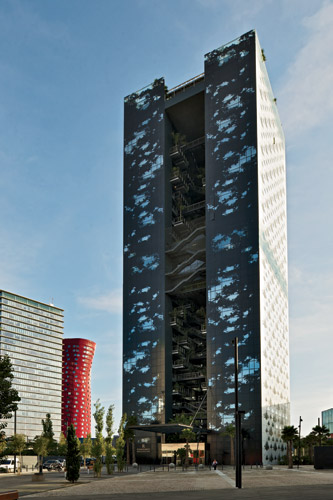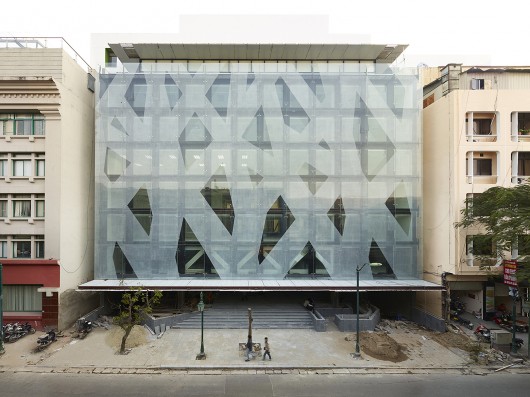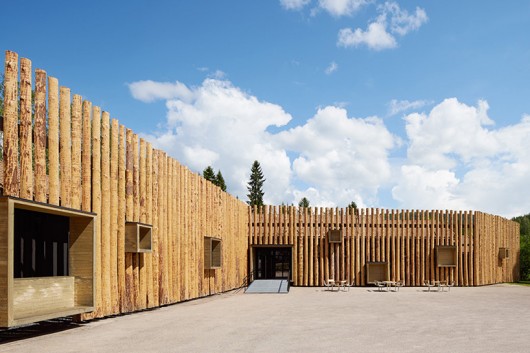 |
| Source: Herzog & de Meuron |
Ricola-Europe SA, Production and Storage Building, Mulhouse-Brunstatt, France, 1998 designed by Herzog & de Meuron
Both long walls are light walls providing the work area with constant, pleasantly filtered daylight. Light filtering occurs through printed translucent polycarbonate façade panels, a common industrial building material. Using silkscreen, these panels are printed with a repetitive plant motif based on photograph’s by Karl Blossfeldt. -- architect's web site
 |
| Source: Christian Richters archdaily.com |
Gingko Project, Beekbergen, The Netherlands, 2007 designed by Casanova + Hernandez Architects
The glazed facade has been specially designed with a print of ginkgo tree leaves of different green and yellow tones that react to the constant changing light of the sky creating very special effects, reflections, shadows and silhouettes, depending on the time of the day and the season of the year. -- ArchDaily
 |
| Source: ABSCIS Architecten archdaily.com |
Service Station Herverlee, Heverlee, Belgium, 2008 designed by ABSCIS Architecten
The principle building is constructed using a ‘superstructure’ consisting of a canopy and a roof. The roof is carried by columns made from white concrete. These columns are positioned in a crisscross formation. Infill modules created in glass, with a negative imprint of leafy trees, slide underneath the super structure to emphasise the transparency of the structure set against the white surroundings. -- ArchDaily
 |
| Source: archdaily.com |
Tattoo House, Victoria, Australia designed by Andrew Maynard Architects
The tattoo was conceived as a continuation of the tree graphic around the simple white box- to soften the impact of this modern addition to a resolutely 19th-century neighbourhood. Furthermore the design was a neighbourly gesture. The household to the west has a manicured garden which is very important to the resident. A stencil of vegetation was created in-house and applied by the AMA team in a covet operation to give the neighbour an additional, though less than manicured, layer of garden. -- ArchDaily
 |
| Source: archrecord.construction.com |
Renaissance Barcelona Fira Hotel, Barcelona, Spain, 2012 designed by Ateliers Jean Nouvel
On the figurative side, Nouvel carries the oasis concept into a branding theme for the facades. Inside every guest room, he cuts a window out of the structural precast-concrete wall in the shape of the jagged crown of a palm tree. Outside, these openings are visible behind a continuous curtain wall of milk-white glass, silkscreened with palms at different scales, that blurs the reading of floor lines. -- Architectural Record
 |
| Source: Dennis Gilbert archdaily.com |
Walsall Housing Group HQ, Walsall, West Midlands, UK, 2011 designed by Bisset Adams
The building has been welcomed as a new landmark with its memorable high performance glazed façade with abstract tree graphic, making reference to the town’s historic arboretum. -- ArchDaily
 |
| Source: Régis Golay archdaily.com |
Coalimex, Hanoi, Hoàn Kiếm District, Hanoi, Vietnam, 2013 designed by group8asia
The main façade, which is directly in contact with the street, gives its strong identity to the Coalimex building and deals with its constraints. It is made of double-layered glass. On the second layer, a pattern that interprets the meeting of the trees of the Hanoi streets and the coal (symbol of the client) is printed on the glass. -- ArchDaily
 |
| Source: Mikkel Frost archdaily.com |
RebildPorten, Rebild, Denmark designed by CEBRA
The structure is designed as a hymn to Nature and the hills and forest, next to which it is situated. It is created in the encounter of building and nature and appears as a sculptural structure made of bluff timber, thus making the building accessible to the eye of the observer – very similar to a forest’s opening and closing when one moves through it, looking upwards through the branches’ chaotic network of crossing lines. By shaping the building out of raw cut timber, the visitor not only experiences a ‘walk in the forest’, and a particular atmosphere determined by Nature’s own strength and rustic weight, but also the scent of wood and nature, which sets the mood for the visit to the forest and hills. -- ArchDaily
 |
| Source: FG+SG archdaily.com |
International Accommodation Center For The Oceanological Observatory, Aquarium de Banyuls sur Mer, Avenue du Fontaulé, 66650 Banyuls-sur-Mer, France, 2013 designed by Atelier Fernandez & Serres
The project, a rectangular monolith entirely coated in a gown of pink-ocher coral, faces the marina. It also marks the limits of the shore and the city. Behind this undulating envelope, access to the bedrooms is provided by large peripheral walkways that also serve as balconies for the accommodations. These walkways are covered with a self-consolidating concrete mesh inspired by a graphic, light and see-through coral design (Gorgones). We developed the facades using a limited amount of distinct shapes, also called strands, that were casted on site. These strands were then assembled in modules according to a simple mathematical algorithm which creates a vibration in the shadows and the matter. -- ArchDaily
 |
| Source: Bornstein Lyckefors archdaily.com |
Torsby Finnskog Center, Torsby, Sweden, 2014 designed by Bornstein
The architects chose to work with raw materials from the forest in the facade. To achieve that, the old school building was smutted black and covered with a veil of standing timber. The facade has openings for entry and extra sunlight intake. Protruding wooden boxes also provides space for benches, signage and artwork. -- ArchDaily
No comments:
Post a Comment